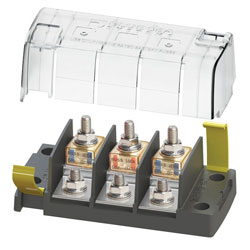About Blue Sea Fuse Block
Wiki Article
The Definitive Guide for Blue Sea Fuse Block
Table of ContentsNot known Details About Blue Sea Fuse Block Indicators on Blue Sea Fuse Block You Should KnowThe Facts About Blue Sea Fuse Block UncoveredThe Single Strategy To Use For Blue Sea Fuse BlockBlue Sea Fuse Block for BeginnersSome Known Questions About Blue Sea Fuse Block.
Fuses are bolted in place between the bus bar as well as the second set of electrically separated bolts. With this installation you can attach the boat's various high-current circuits, such as a windlass, bow thruster, high-output alternator, the DC panel, etc, to the isolated bolts. The various fuses are sized according to the current-carrying capability of the conductors bolted to them.Some circuits will still require to bypass the seclusion button so that they may be left on when the rest of the boat is closed down. blue sea fuse block. These circuits commonly include a bilge pump and any kind of billing tools (consisting of solar panels, possibly a wind generator, and also the inverter if it additionally functions as a battery charger).
This becomes part of the circuit diagram we developed for the complicated instance boat in our Watercraft Electrics training course. The gadgets linked to the fuse block in the upper right are all bypassing the isolation switch S1. If you sign up for Watercraft Electrics 101, you will learn just how to review such a diagram and additionally exactly how to make one for your own boat.
Some Known Factual Statements About Blue Sea Fuse Block

With DC circuits, the OCP is constantly put in the positive side of DC circuits. Note that some European boatbuilders install fuses and battery switches in the DC negative side and on the favorable side, yet this is not advised other than in some separated (drifting) ground DC systems.
This factor may be at the battery, the battery switch, the circulation panel, a subsidiary panel, some circulation bus bar, or other connecting factor. If the conductors in the new circuit are no smaller than the conductor that feeds the brand-new circuit's point of connection, after that the OCP for the feeder conductor will adequately secure the new circuit - blue sea fuse block.
5 Easy Facts About Blue Sea Fuse Block Explained
However if the brand-new circuit is not properly offered by overcurrent devices currently in location, added security is called for at its point of connection, i. e., at its source of power. Placement of merges in the favorable conductor. Keep in mind just how a smaller fuse is utilized each time a smaller sized conductor is attached, In some cases room limits just how close an OCP tool can be placed to the resource of power.The generic solution, from the ABYC, is within 7" (17. The ABYC allows the adhering to, which have actually been tightened up in recent years: A conductor connected directly to a battery that is likewise "consisted of throughout its whole range in a sheath or unit such as a conduit, junction box, control box or enclosed panel" should have its overcurrent security "as close as possible to the battery, however not to surpass 72 inches (1.
Gone is the blanket 72" allocation that utilized you can try these out to be there. A conductor linked to a resource of power besides the battery (e. g., the battery switch, the distribution panel, or a few other point in the DC circuits) that is similarly included in a sheath, etc, must have its overcurrent protection "as close as practicable to the factor of link to the resource of power, however not to surpass 40 inches (1.
Things about Blue Sea Fuse Block
e., any place it ties into the DC system. Offered that alternators themselves are a source of power, it has actually been arguable whether these included generators required OCP at the generator itself. This has been dealt with in the latest variation of the ABYC E-11 requirement as follows: "Overcurrent security is not needed at a generator if the ampacity of the conductor amounts to or higher than the ranked output of the generator."Cranking-motor circuits are not required to have overcurrent defense.In the aquatic area, where cranking circuits might be long, this method could produce a hazard. If a vehicle ignites, the residents can draw over as well as leap out. If a boat catches fire, it is not so straightforward. It makes no sense to have any kind of vulnerable circuits on a watercraft.
In winter, the inrush present on a 12V starter motor may be as high as 1,500 description amps; the cranking current might be as much as 200 amps. Frequently, cranking conductors are undersized even for the cranking present, not to mention the inrush current. This circumstance does not posture a safety trouble per se, because these currents are endured for just a couple of secs, so the conductors do not have time to fume adequate to develop a fire hazard.
The Of Blue Sea Fuse Block
We made the program with absolute newbies in mind. As the electric tons on boats rises, so also does the complexity of electrical circuits and also the possibility for short circuits as well as electrical fires.
In the aquatic field, where cranking circuits may be long, this technique might create a hazard. If a car ignites, the owners can pull over as well as leap out. If a boat ignites, it is not so easy. It Extra resources makes no feeling to have any unprotected circuits on a watercraft.
Fascination About Blue Sea Fuse Block

We made the program with outright beginners in mind. As the electric tons on watercrafts boosts, so also does the complexity of electric circuits and the possibility for short circuits and also electrical fires.
Report this wiki page